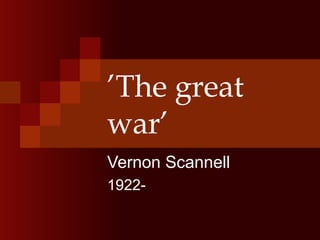
The great war’.ppt giulia
- 2. Pg 223 The Great War By Vernon Scannell 1922- Presentation by Giulia Enright
- 3. Background INFO Vernon Scannell, whose real name was Johnny Bain, was born in 1922 in Spilsby, Lincolnshire. The family, always poor , moved frequently: Finally moving to Buckinghamshire, where his father, who had fought in the First World War, developed a reputation as a good portrait photographer and the family’s severe financial difficulties began to ease. Scannell left the local council school at the age of fourteen and got a job in an accountant’s office. His real passions, however, were for the unlikely combination of boxing and literature. He had been winning boxing titles at school and had been a keen reader from a very early age, although not properly attaching to poetry until about aged fifteen, when he picked up a Walter de la Mare poem and was "instantly and permanently hooked".
- 4. Background INFO Awards He received the Heinemann Award for Literature in 1961 and the Cholmondeley Award for poetry in 1974. He was elected a Fellow of the Royal Society of Literature in 1960 and granted a Civil List pension in recognition of his services to literature in 1981. He also received a special award from the Wilfred Owen Association "in recognition of his contribution to war poetry". Scannell's best-known book of war poetry is Walking Wounded (1965). The title poem recollects a column of men returning from battle: "No one was suffering from a lethal hurt, They were not magnified by noble wounds, There was no splendour in that company."
- 5. An Over view of the poem •Vernon scannell personifies the so called ‘great’ war that ‘invades the mind’- invades not being a good thing. •He gives the war emotion like ‘slyly’ and ‘sensuous’. •He concentrates on the aspects held in mind when talking about world war 1, the realities such as flares and corpses. •Talks about what occurred during the war, talks about common things that happened to the soldiers such as terror, shells, exploding and ‘sudden fans of smoke’.
- 6. Imagery ‘The sky at night, is honoured with rosettes of fire’- Scanell uses the contrast between beautiful nature such as the night sky with the constant fire of war. Could link to ‘lie’ of the ww1 that is was good to fight for your country because scannell uses quite romantic images like ‘the night sky’ and ‘rosettes’ which compared to the rest of the poem is quite ‘sugar coated’ and light in contrast to the sinister imagery used through out such scattered corpses, rats and exploding shells. Could also link in with the title ‘great’ war that the sky was ‘honoured with rosettes’.
- 7. Imagery ‘flares that define the corpses on the wire’- he paints a picture of soldiers, friends and comrades scattered on the barbed wire in no mans land and how the constant treat of enemies ‘defines’ who they are through the use of the flare. That they will be known not by their bravery or their valour to their country or as fellow soldiers but as simply ‘corpses on the wire’. Scannell shows no compassion in this line, he shows that there was in fact no compassion for the soldiers, for example the home front, who risked their lives for their country, they were simply ‘toys’ in a ‘game’ of war.
- 8. Structure There are no stanzas – to show the constant pain of the soldiers, there was no release from the terror that they were witnessing because it was a compete contrast from their lives at home, it was nothing they could of imagined, it came as a shock which links the length of the poem as there is no breathers no time to think while reading the poem, which links the way the soldiers where suffering, it all came down to natural instincts.
- 9. Mood The poem has a constant feel of death and ‘darkness’, quite graphic with the ‘corpses on the wire’ . There is an obvious sinister feel unvarying in the poem through the use of ‘terror ticks' or ‘blind murders' or ‘ sudden fans of smoke and earth’.
- 10. Purpose I thought the poem serves a purpose to open the eyes to the realities of war. That in the end the war was not so ‘great’ to show the irony of the so called great war. To show the suffering of those fighting in war we won but a battle we lost. For example The government lost respect , mothers lost sons ,sons lost fathers and so on.
- 11. Perspective There is a change in perspective evident where he starts in a past where he describes the ‘terror’ and torture of soldiers then goes into the aftermath and describes the almost funeral like feel ‘through the misty keening of a band of Scottish pipes’.
- 12. Further works of Vernon Scannell Nettles Nettles by Vernon Scannell.wmv - YouTube
